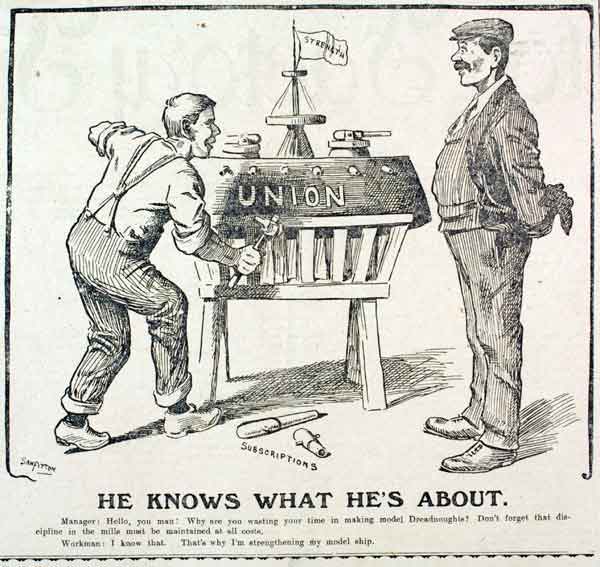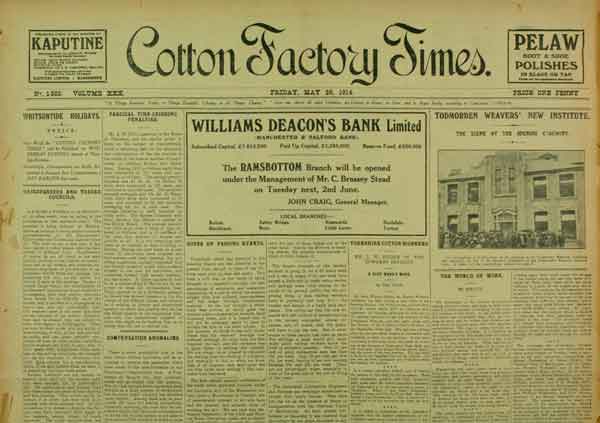
This website features cartoons about the cotton industry in Lancashire in the early twentieth century. They were drawn by Sam Fitton and featured in the pages of the Cotton Factory Times. They provide a unique visual commentary on what was one of the country's leading industry and the problems faced by the men, women and children who worked in its factories.

Cotton Factory Times
The Cotton Factory Times, established in 1885, was the public voice of the principal Lancashire cotton trade unions - the Spinners, the Weavers and the Cardroom operatives. The weekly newspaper was not owned by the unions but by the Andrew family, proprietors of the Ashton Reporter. Contributors included the leading cotton trade unionists, James Mawdsley and Thomas Ashton. A regular feature was 'Voices from the Spindle and the Loom', comprising reports from local correspondents on the region's industrial news. As well as carrying union and industry news, the newspaper developed a significant entertainment section, including serialised novels and dialect tales. Another popular feature was 'Mirth in the Mill', a column comprising jokes sent in by readers. The best joke each week won a prize. There were also features for women and children. In 1907 the paper began to include a weekly cartoon that commented on the lives of the cotton operatives and the problems that they faced in the industry. The artist was Sam Fitton.
Sam Fitton
Sam Fitton was one of the best-known Lancashire dialect writers in the early twentieth century. He was also a cartoonist of more than local significance. Born in Cheshire in 1868, he lived almost his entire life in and around High Crompton, a village between the great cotton towns of Oldham and Rochdale. It was here that he developed his interest and passion for the Lancashire dialect culture. A number of his verses - 'Eawr Sarah's Getten a Chap' and 'My Owd Case Clock' - became standards in the dialect repertoire. Fitton was also a marvellous mimic and comic entertainer. He was above all a Lancashire man with a Lancashire view of the world, or as one of his friends described him, 'a gradely man with a gradely sense of humour'.
Fitton's artistic talent also expressed itself in his love of drawing. It was this that was to make him an even more popular figure when, in 1907, he began to contribute a weekly cartoon to the Cotton Factory Times, a newspaper that circulated among the mill workers of Lancashire. He contributed over 400 cartoons to the newspaper over the next twelve years, creating a unique visual record of the cotton industry, its workers and the communities in which they lived. He also contributed a regular dialect column called 'Rustic Ruminations' featuring Peter Pike. Almost all of Fitton's cartoons were accompanied by a verse, often in dialect, always humorous. These cartoons are reproduced in chronological order on this website.
Sam Fitton died of cancer in 1923. He is buried in Crompton Cemetery. The headstone marking his grave reads
In loving memory of Samuel Fitton
Lancashire author, playwright, cartoonist etc.
The circulation of the Cotton Factory Times peaked during the Edwardian years, though it is difficult to estimate readership as in close communities a single copy of the paper would be read by workmates and neighbours. Fitton drew a number of cartoons encouraging operatives to buy their own copy of the paper! After 1914 the paper declined with the fortunes of the industry, finally ceasing publication in 1937. The paper remained in the ownership of the Andrew family who kept the title registered, presumably optimistic that the fortunes of the Lancashire cotton industry would revive.
Cotton Conundrums

The 'Mirth in the Mill' column contained jokes and humorous stories sent in by readers. It also included conundrums such as these:
Why are minders the most obstinate people? They have been reared amongst mules.
Why is a twister the most remarkable man in a mill? Because he can always make ends meet and be going backwards all the time.
What's the difference between a weaver and a pillow? One's hard up and the other's soft down.
Why is a cutlooker like a policeman? Because they both prevent breaches of the peace (piece).
Why is it called a mule? Because it is owned by a tight-fisted ass.
Why is a piecer running to the station like a runner exercising? Because one is racing for a train and the other training for a race.
What constitutes a tackler? A man wi' kindly ways, wearing a smile as he walks between th' slays an' helping poor weavers on booking up days.
Who would make the best twister in a mill? The minder, because he twists the piecer out of as much screw as he can.
Why is the Cotton Factory Times like a Treasury note? It is well circulated, offends no one, and is welcome to all its readers.
Further Reading
A book of Sam Fitton's poems, Gradely Lancashire, was published posthumously in 1929. The collection has an introduction by his friend and fellow dialect writer, Ammon Wrigley. It includes some of his illustrations.
Oldham Local Studies Library holds the most important collection of archives relating to Sam Fitton, including original cartoons and other drawings, writings and correspondence. It also contains notebooks, manuscript and typescript copies of plays, poems, comedy routines and song lyrics. Oldham Art Gallery has a number of his paintings.
Studies of Sam Fitton and the Cotton Factory Times include:
Eddie Cass, 'Factory fiction in the Cotton Factory Times', Manchester Region History Review, 8 (1994) pp. 32-43
Alan Fowler and Terry Wyke, Mirth in the Mill: the Gradely World of Sam Fitton (Oldham Leisure Services, 1995)
Eddie Cass, Alan Fowler and Terry Wyke, 'The remarkable rise and long decline of the Cotton Factory Times', Media History, 4 No. 2 (1998) pp. 141-59
Appeal for Fittonia
Sam Fitton was a compulsive scribbler and doodler. He does not appear to have been able to write a letter or postcard without including a small drawing or humorous remark. We would be grateful for any information relating to Fitton's work not in public archives.
Acknowledgements
The images reproduced on this site have been taken from copies of the Cotton Factory Times kindly provided by Tameside Local Studies Library and Manchester Metropolitan University Library. We are indebted to Stephen Yates for photography.
They should not be reproduced without permission and appropriate acknowledgement of this website.
Alan Fowler and Terry Wyke